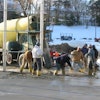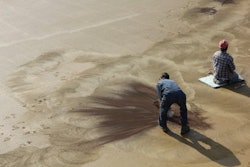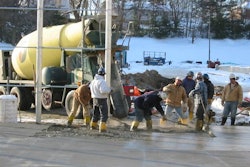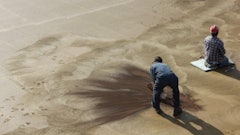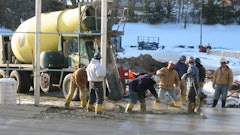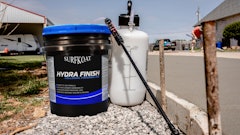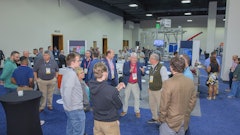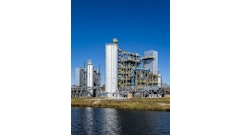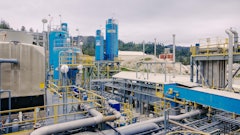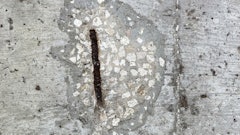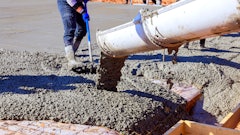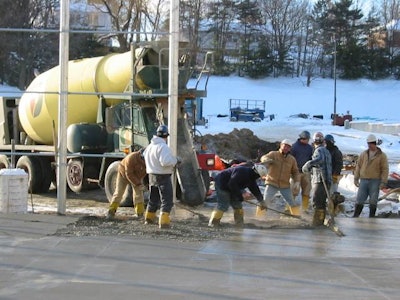
As temperatures drop, concrete contractors face a familiar dilemma: push through winter or shut down until spring. For decades, cold weather has carried an aura of risks like delayed set times, weak early strength, increased cracking, and scaling. But the truth is that cold-weather concreting is not inherently problematic. What undermines performance isn’t the climate but the persistence of outdated myths and shortcuts that ignore the underlying science of hydration, temperature, and time.
Modern materials, sensors, and admixture technologies have dramatically expanded what’s possible during the cold winter months. The key lies in understanding that concrete doesn’t respond to the calendar — it responds to chemistry. When properly managed, concrete placed in subfreezing conditions can meet or even exceed the performance of summer pours.
 Cold weather doesn’t have to halt construction. Proper preparation ensures concrete continues to cure safely, even in winter conditions.The Euclid Chemcial Company
Cold weather doesn’t have to halt construction. Proper preparation ensures concrete continues to cure safely, even in winter conditions.The Euclid Chemcial Company
In many cases, modest temperature control combined with these admixtures achieves the desired strength gain far more effectively than altering the cement content.
Myth 1: 'Just Add More Cement'
One of the most common cold-weather misconceptions is that increasing cement content will “heat up” the mix enough to offset low temperatures. Although cement hydration does in fact produce heat, the additional energy is temporary and rarely sufficient to prevent freezing during the first few critical hours after placement. To add to this, raising cement content without rebalancing water, aggregate temperature and admixtures disrupts the designed water-cementitious ratio, leading to excessive shrinkage, higher permeability and long-term durability loss.
Instead, the right approach is to maintain the designed water-to-cementitious ratio (typically between 0.40 and 0.50) and use chemical accelerators to promote early hydration. Non-chloride accelerators based on calcium nitrate or calcium formate initiate C₃S hydration more efficiently, allowing the mix to reach its initial set faster without compromising long-term performance.
In many cases, modest temperature control combined with these admixtures achieves the desired strength gain far more effectively than altering the cement content.  Optimizing winter concrete starts in the lab, where accelerators and mix designs are fine-tuned for durability and safety.The Euclid Chemcial Company
Optimizing winter concrete starts in the lab, where accelerators and mix designs are fine-tuned for durability and safety.The Euclid Chemcial Company
Myth 2: 'Concrete Only Freezes Below 32° F'
Freezing damage starts long before the concrete mix reaches 32° F. Hydration slows sharply once concrete temperatures fall below 50° F, and by the time it nears 40° F, the reaction between tricalcium silicate (C₃S) and water is sluggish enough to double or triple set times.
The danger zone occurs when the in-place concrete drops below freezing before it achieves roughly 500 psi (3.4 MPa). At that stage, pore water inside capillaries can freeze and expand, creating microcracks that compromise strength and durability — even if they remain invisible for weeks.
This damage often reveals itself later as surface scaling, delamination or popouts under freeze-thaw cycles and deicing salts. The underlying issue isn’t temperature alone but inconsistent curing conditions that interrupt the formation of calcium silicate hydrate (C-S-H) — the backbone of concrete’s strength. Successful cold-weather concreting requires maintaining a stable, continuous temperature regime from batching through curing, not just protecting the surface on placement day.
For structural, post-tensioned or decorative concrete, chloride-based accelerators introduce unacceptable risk.
Myth 3: 'Calcium Chloride is the Best Accelerator'
To this day, calcium chloride remains one of the most efficient accelerators ever developed. Its chloride ions significantly boost early strength by accelerating hydration of C₃S and C₂S phases. However, these same chlorides can initiate corrosion in embedded reinforcement and cause efflorescence or discoloration in exposed surfaces. For structural, post-tensioned or decorative concrete, chloride-based accelerators introduce unacceptable risk.
Modern non-chloride formulations offer comparable acceleration without corrosion potential. Calcium nitrate and calcium formate, for example, form stable complexes with C₃A that promote early strength gain while maintaining the passive layer on steel. Triethanolamine-based blends are also gaining traction for their compatibility with water reducers, air-entraining agents and supplementary cementitious materials (SCMs). These admixtures provide contractors with the flexibility to tailor the performance of a concrete mix — whether for early form removal, finishing speed or protection against freeze-thaw stress — without compromising its long-term durability.
 Insulation and curing blankets are key tools for protecting early-age concrete from freezing, ensuring durability and long-term performance.The Euclid Chemcial Company
Insulation and curing blankets are key tools for protecting early-age concrete from freezing, ensuring durability and long-term performance.The Euclid Chemcial Company
Myth 4: 'You Can Skip Heating if You Pour During the Day'
Sunlight offers little thermal protection once ambient temperatures fall. Concrete placed on a frozen or saturated subgrade will lose internal heat far faster than it can generate it. When base materials remain below freezing, ice lenses can form under the slab, leading to differential heaving and long-term cracking. Even in daytime conditions, unprotected edges and corners cool rapidly, producing nonuniform strength development and surface curling.
Effective temperature management begins before the first batch is delivered. Aggregates should be warmed to around 100° F and mixing water limited to 140° F to achieve a concrete discharge temperature between 55° F and 65° F. In addition, subgrades must be thawed, drained and insulated prior to placement. Once the concrete is down, it should be covered immediately — preferably with insulated curing blankets or placed inside heated enclosures — to retain heat until it reaches at least 500 psi. For larger placements, hydronic heating lines or heated formwork maintain uniform temperature distribution, reducing thermal gradients that cause stress cracking.
Contractors should monitor in-situ temperatures with embedded thermocouples or maturity sensors to confirm that strength thresholds have been met before removing insulation. As a rule of thumb, maintaining surface temperatures above 50° F for the first 48 hours and above 40° F for the following three to five days post-placement ensures adequate curing under most conditions.
These practices align with the recommendations in ACI 306R, “Guide to Cold Weather Concreting,” which remains the industry benchmark for thermal protection and curing duration.
 Ignoring cold-weather measures can lead to microcracks and scaling, while disciplined curing delivers a strong, defect-free surface.The Euclid Chemcial Company
Ignoring cold-weather measures can lead to microcracks and scaling, while disciplined curing delivers a strong, defect-free surface.The Euclid Chemcial Company
Myth 5: 'Cold-Weather Measures Are Too Costly'
Heating and insulation may seem like additional expenses, but they are small compared to the cost of rework, scaling or structural remediation caused by early-age freezing. Protecting concrete for the first 72 hours can increase ultimate compressive strength by up to 30 percent, according to ACI data. When you factor in the productivity gains from an extended construction season and fewer winter shutdowns, it becomes clear that cold-weather best practices deliver a tangible financial return.
Temperature management also doesn’t have to rely solely on fuel-intensive enclosures. Energy-efficient technologies such as hydronic ground heating, insulated form systems and low-emission propane heaters now allow contractors to maintain consistent temperatures with lower operating costs. To add to this, the integration of digital maturity monitoring streamlines the decision-making process which reduces the over-curing time and allows earlier form removal or loading.
Viewed from a strategic perspective, cold-weather concreting is actually not a liability but an opportunity to gain a competitive advantage. Contractors who can maintain quality and schedule year-round can become more dynamic, trusted partners for owners with tight delivery timelines.
 With science-based strategies, contractors can maintain winter productivity and deliver quality concrete year-round.The Euclid Chemcial Company
With science-based strategies, contractors can maintain winter productivity and deliver quality concrete year-round.The Euclid Chemcial Company
At its core, cold-weather concreting is about mastering the science behind performance.
From Science to Strategy: Mastering Winter Concreting
At its core, cold-weather concreting is about mastering the science behind performance. Hydration never truly stops in cold conditions; it simply slows, requiring precision in temperature control, mix optimization and curing discipline. When contractors understand how to manage these factors together, winter placements become an opportunity to prove that technical expertise.
Modern admixture technology makes this control possible. Non-chloride accelerators initiate early hydration safely, while shrinkage-reducing and air-entraining admixtures mitigate thermal stress and freeze-thaw damage. Adjusting SCMs ensures predictable set times and long-term strength. Each of these levers, from chemistry to curing, can be calibrated for project-specific needs.
Technology like wireless temperature and maturity sensors can also deliver real-time data on internal slab conditions, allowing crews to verify strength gain and optimize protection durations. This data-driven approach reduces guesswork, prevents premature form removal, and provides documentation that strengthens contractor credibility with engineers, inspectors and owners alike.
Ultimately, the contractors who succeed in cold weather are those who view science as strategy. They don’t just pour concrete—they manage a chemical process in motion, measured and verified through data. Winter work becomes a proving ground for precision, discipline and technical mastery.



